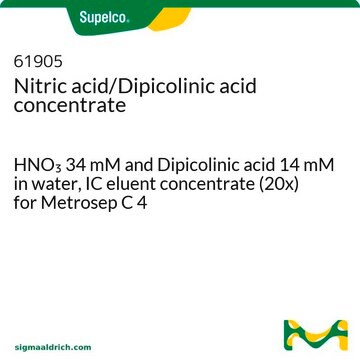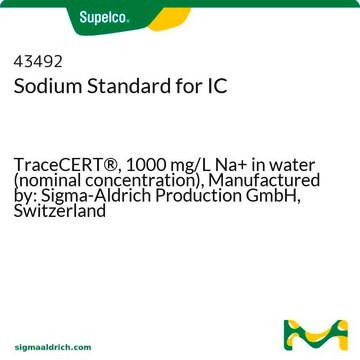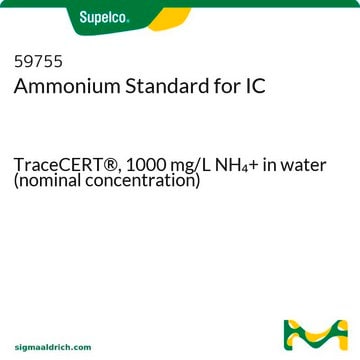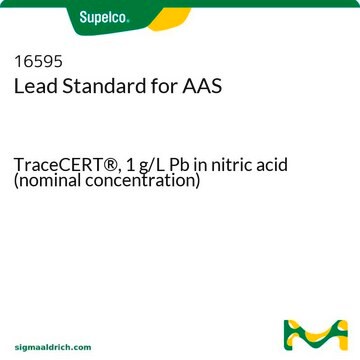50972
2,6-Pyridinedicarboxylic acid concentrate
0.02 M C7H5NO4 in water (0.04N), suitable for ion chromatography, eluent concentrate
Synonym(s):
2,6-Pyridinedicarboxylic acid solution, Dipicolinic acid solution
Sign Into View Organizational & Contract Pricing
All Photos(1)
About This Item
Empirical Formula (Hill Notation):
C7H5NO4
CAS Number:
Molecular Weight:
167.12
MDL number:
UNSPSC Code:
12000000
eCl@ss:
39151816
PubChem Substance ID:
NACRES:
NB.21
Recommended Products
description
anionic
Quality Level
concentration
0.02 M C7H5NO4 in water (0.04N)
technique(s)
ion chromatography: suitable
SMILES string
OC(=O)c1cccc(n1)C(O)=O
InChI
1S/C7H5NO4/c9-6(10)4-2-1-3-5(8-4)7(11)12/h1-3H,(H,9,10)(H,11,12)
InChI key
WJJMNDUMQPNECX-UHFFFAOYSA-N
General description
This eluent concentrate for ion chromatography is determined by potentiometric titration. Content and expiry date can be found on the certificate.
Application
Linkage
Visit the IC Portal to learn more
Preparation Note
Prepared with 2,6-pyridinecarboxylic acid and high purity water (18.2 MΩ, 0.2 μm filtered)
related product
Product No.
Description
Pricing
Storage Class Code
10 - Combustible liquids
WGK
WGK 2
Flash Point(F)
Not applicable
Flash Point(C)
Not applicable
Personal Protective Equipment
dust mask type N95 (US), Eyeshields, Gloves
Choose from one of the most recent versions:
Already Own This Product?
Find documentation for the products that you have recently purchased in the Document Library.
Customers Also Viewed
Chao Xu et al.
Inorganic chemistry, 52(5), 2750-2756 (2013-02-21)
Complexation of UO2(2+) with dipicolinic acid (DPA) has been investigated in 0.1 M NaClO4. The stability constants (log β1 and log β2) for two successive complexes, UO2L and UO2L2(2-) where L(2-) stands for the deprotonated dipicolinate anion, were determined to
C C J van Melis et al.
International journal of food microbiology, 160(2), 124-130 (2012-11-28)
In this study, the impact of a range of organic acids and structurally similar alcohols with three to six carbon backbones and increasing lipophilic character, were tested on the germination behavior of B. cereus ATCC 14579 spores. This approach allowed
Chaoliang Tan et al.
Chemical communications (Cambridge, England), 47(46), 12521-12523 (2011-10-27)
An effective single-walled carbon nanotube (SWNT) covalently loaded with unsaturated terbium emissive material was designed for specific and rapid (2-3 s) detection of calcium dipicolinate (CaDPA) (detection limit 1 μM). The nanoprobe was successfully assembled onto electrodes and its sensing
Kai Reineke et al.
International journal of food microbiology, 162(1), 55-63 (2013-01-29)
High pressure combined with elevated temperatures can produce low acid, commercially sterile and shelf-stable foods. Depending on the temperature and pressure levels applied, bacterial endospores pass through different pathways, which can lead to a pressure-induced germination or inactivation. Regardless of
Development of metal-chelating inhibitors for the Class II fructose 1,6-bisphosphate (FBP) aldolase.
Geneviève Labbé et al.
Journal of inorganic biochemistry, 112, 49-58 (2012-05-02)
It has long been suggested that the essential and ubiquitous enzyme fructose 1,6-bisphosphate (FBP) aldolase could be a good drug target against bacteria and fungi, since lower organisms possess a metal-dependant (Class II) FBP aldolase, as opposed to higher organisms
Our team of scientists has experience in all areas of research including Life Science, Material Science, Chemical Synthesis, Chromatography, Analytical and many others.
Contact Technical Service







